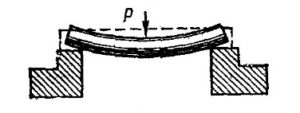Teaching activity planned by Anastasiia Plotnikova and Biagio Ambrosio during the PhD course “Designing innovative public engagement activities”, held at the University of Padua in 2022.
Which forces oppose gravity? Archimedes’ force, friction force, magnetic force and binding reaction.
Experience the challenge between gravity and each of these forces to find out, who wins each time.
Materials
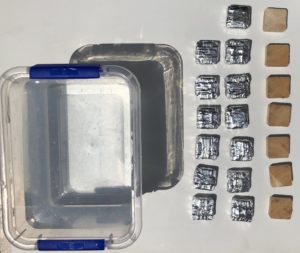
- half-painted inclined countertop
- water containers
- shoe box
- magnets
- wooden cues
- nails
- copper wire
- aluminium foil
- glue
- paper sheets
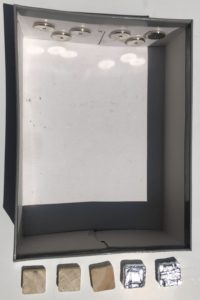
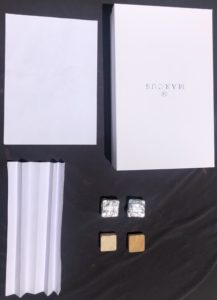
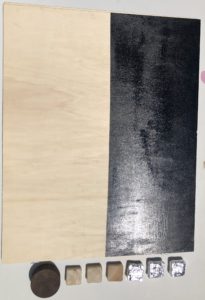
For the tinkering table:
- half-painted inclined countertop
- water containers
- shoe boxes
- magnets
- copper wire
- paper sheets
- long toothpicks for skewers
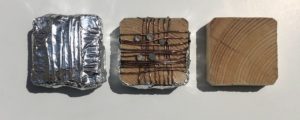
Note: half of the wooden cubes should be filled with 12 nails (2 nails for each face of the cube), coated with copper wire and an aluminium layer. This allows us to realize ‘metallic’ cubes cheaply. The metal cubes we will mentions have been built in this way.
Description of the activity
During this activity, participants will experience the challenge between gravity and other forces. The activity is divided into four ‘stages’: in each of them, gravity will challenge one of the following forces:
- Force of Archimedes
- Friction Force
- Magnetic force
- Reaction force
At the end of the expermient, prepare a tinkering table.
Preparation:
1. Force of Archimedes: put the containers on the table, with enough distance between them and the edges; then fill the containers with water up to a level of about 4 cm from the top of the top of the container.
2. Friction force: put the inclined plane on the table and fix it with something stable (rocks are good, if you do not have such objects available, try keep the base of the plane steady with the hands). At the start, the plane must have a low inclination (Figure 1).
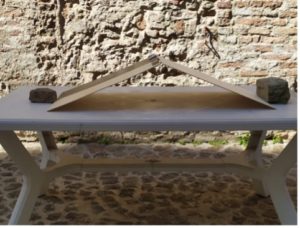
Figure 1
3. Magnetic force: remove the shoe box lids and place them on the table, using the smaller faces as a base; then fix the magnets on the inside of the upper face with the glue (Figure 2).
4. Force of reaction: place two shoe boxes (with lids) on the table, using as a base the smaller faces. Also keep handy paper sheets.
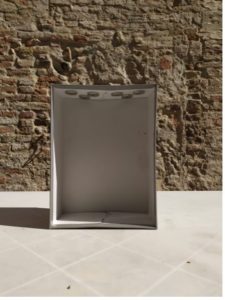
Figure 2
Tinkering table: place on this table the material indicated in the section ‘For the tinkering table’.
Preliminary Activity:
Each participant receives a wooden cube and a metal cube (different from the four ones presiding over various stages of the experiment) (Figure 3).
The teacher may introduce the activity, explaining the history of the challenge between gravity and other forces to participants.
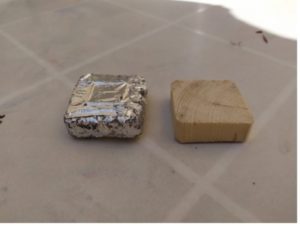
Figure 3
Carrying out the experiment:
Force of Archimedes
The teacher shortly presents the force of Archimedes, then asks participants to put into the water (Figure 4) the wooden and the metal cubes, so as to show how the force of Archimedes acts with different materials.
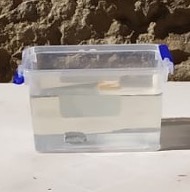
Figure 4
Friction force:
The teacher briefly introduces the friction force, then asks participants to try and let their cubes fall along the inclined plane, using only the unpainted part (Figure 5): the metal and the wooden cubes fall at different speed, because friction depends on materials.
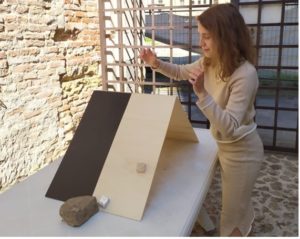
Figure 5
Now the teacher asks two participants to place their wooden (or metal) cubes – the main thing is that they should be made of the same material – upon two different parts of the plane (Figure 6), one cube on the painted part and one on the unpainted part, at the same height, and let them fall: even though the cubed have the same weight, the one falling along the painted part of the plane is slower, because the paint increases the friction of the plane and therefore gravity makes more effort.
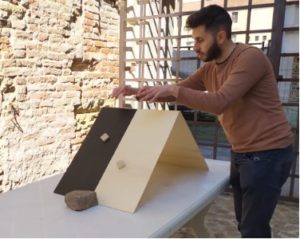
Figure 6
Magnetic force:
The teacher briefly introduces the magnetic force, then asks participants to place the cubes on the inside of the upper face of the box (where magnets are glued) and let them fall down (Figure 7). We can see that the magnetic force only acts with metals.
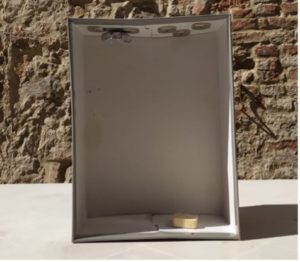
Figure 7
Reaction Force:
The teacher briefly introduces the reaction force, then places the lid of one of the boxes like a bridge between the two boxes and asks participants of placing cubes on top (Figure 8). The cubes do not fall. Afterwards, the lid is replaced with a sheet of paper. Now the cubes fall (Figure 9). At this point, you can ask participanta how to make paper stronger. They may discover that by folding it, the paper sheet may become strong enough to prevent the cubes from falling ripiegando (Figure 10).
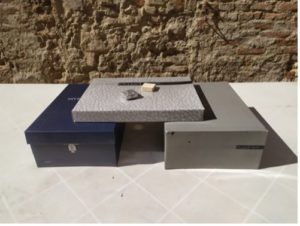
Figure 8
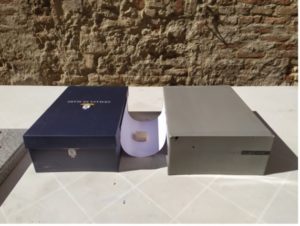
Figure 9
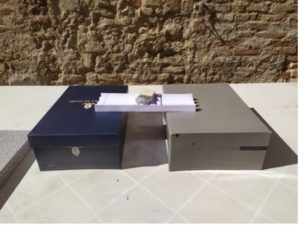
Figure 10
In the end, all participants reach the tinkering table. Here participants may have fun with cubes, paper, magnets and all the objects available, putting into practice what they have learned.
Explanation of the physical process
Gravity is the force that causes all massive objects in the Universe to attract each other. Light has no mass, but it also suffers the effects of gravity, which can bend its trajectory. This force explains why planets orbit around stars, and also why objects fall down here on Earth: as Isaac Newton discovered, the force attracting the Earth towards the Sun is the same which attracts an apple towards the ground: namely, gravity.
However some other forces can counteract the action of gravity, acting in the opposite way:
The force of Archimedes turns up every time a body is immersed in a fluid material (not only in the water, but also in the air!). This force is opposed to gravity and its value is given by the weight of the volume of fluid moved by the body. Therefore, the crucial point is density: if the body’s density is higher than the fluid’s one, gravity is stronger than the force of Archimedes, and the body sinks, whereas in the opposite case, the force of Archimedes is stronger and the body floats.
The key parameter for this force is density.
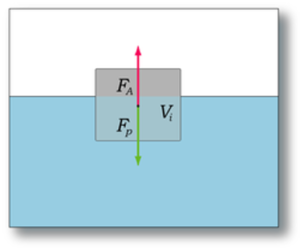
Friction is a force deriving from two bodies in contact and depends on the materials which compose them.
Smooth materials generate less friction, whereas rough materials generate more friction. Even the shape of the bodies plays a role: friction behaves differently in square bodies (sliding friction) and in round (rolling friction).
Even falling objects are affected by the friction, originating from the contact with the air.
In this experiment we are dealing with friction between solids.
Friction between a body and a surface is proportional to the body mass, but is also connected to the material ( both od the body and of the surface) through a quantity called friction coefficient: the greates this quantity, the stronger the friction.
In the case of the inclined plane, the friction force decreases with increasing plane inclination.
The key parameters for this force are: body mass, materials, plane inclination.

The magnetic force acts upon materials with magnetic properties, such as iron, cobalt, nickel, etc, but also a few alloys of magnesium, chromium and uranium. All these materials show these properties when they are near enough to a source of magnetic force, such as a magnet. Objects composed of materials of this kind are attracted by the source.
However, in the case of its sources, the situation is more complex. The magnets, indeed, have two poli: opposite poles attract each other, while equal poles repel each other.
Unlike the other forces we have examined, magnetic force acts also at a distance, but its force decreases as distance increases.
Key parameters for this force: materials, distance.
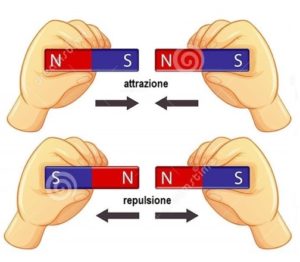
The force of reaction turns up every time a body tries to resist a deformation. The body resists until the force deforming it overcomes its breaking point. When an object is placed upon a surface, it tends to fall because of gravity and therefore to deform the surface. Therefore the surface develops a force of reaction opposing gravity, until it is strong enough. However, of the body’s weight exceeds the surface’s breaking point, the latter will break up. In some cases, the surface’s resistance can be modified by changing its geometry: folding a sheet on itself is a simple way of malking it more resistant.
Key parameters for this force: breaking point and geometry of the material.
